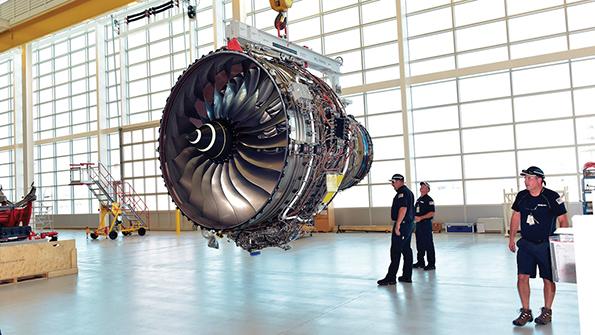
When Rolls-Royce’s Trent 1000 first powered a Boeing 787 in the summer of 2007, it was viewed as an important milestone in the engine-maker’s long-term success in the commercial aerospace industry. The company already enjoyed a near-50% share of the widebody engine market, and its new Trent 1000 would compete with GE Aviation’s GEnx on the 787, which was expected to be one of the omnipresent aircraft of the widebody fleet. After gaining a joint FAA and European Union Aviation Safety Agency certification, the Trent 1000’s eventual entry into service in October 2011 was relatively smooth. Japan’s All Nippon Airways (ANA) operated the powerplant’s first commercial flight from Tokyo to Hong Kong.
Large orders soon followed and surpassed more than 300 by the first quarter of 2014, all commited to Trent 1000-powered 787s. However, less than two years later, in early 2016, the start of several major program disruptions occurred. Launch customer ANA discovered corrosion-related fatigue cracking of intermediate-pressure turbine blades, which eventually led to several airlines grounding their aircraft before fixes were initiated.
Over the next four years, technical issues would affect each of the three engine variants: the Package B, Package C and TEN. The TEN experienced issues related to its high-pressure turbine blades, which led to their redesign and replacement. More than 40 Trent 1000-powered 787s were grounded at its height. Rolls worked to bring this down to single figures in the second quarter of this year, despite 2020 seeing an industry affected exponentially by the COVID-19 crisis and its resulting manpower reductions. Regardless, as of this past summer, Rolls said engine program issues largely had been resolved.
Despite these lengthy and expensive financial challenges, Rolls nevertheless remains bullish about the long-term market for the Trent 1000. At the beginning of 2021, Aviation Week Fleet & MRO Forecast data estimates 770 of the Rolls-powered 787s will be in service, making up 35% of the 787 engine market. While this will be nearly two-thirds fewer than the number of in-service GEnx rival powerplants, which will account for 1,436 units in the commercial fleet next year, the overall market has a projected healthy compound annual growth rate of 8.7% from 2021 to 2030.
However, the number of in-service Trent 1000s will continue to be outstripped by the GEnx, whose share Aviation Week estimates will increase to 70% of the 787 market by the end of the decade—2,810 GEnx-powered 787s are anticipated to be in service by 2030, compared to 1,192 of Trent 1000-powered aircraft.
Naturally, as the program matures and more aircraft enter service, more shop visits are expected. From 2021 through to 2030, Aviation Week data foresee approximately 1,460 shop visits for the Trent 1000, with a peak projected in 2029.
In the past two years, Rolls has looked to expand its Trent 1000 repair network to meet the expected backlog resulting from the grounding of engines while also ensuring long-term capacity is available. Two existing sites operated by the British engine-maker in Dahlewitz, Germany, and at Montreal, which previously focused on business aviation, were given Trent 1000 overhaul capabilities in November 2019. The company also secured the use of an additional testbed in the U.S. at Dallas-Fort Worth International Airport to support Trent 1000 engine tests while it also further grew capacity for the engine at its English headquarters in Derby and an overhaul facility at London Heathrow Airport.
Rolls also has moved to expand its partner network of external Trent engine repair specialists. U.S.-based Delta TechOps formally joined the aftermarket network in 2019 to aid with issues on the engine type. Shortly afterward, Delta TechOps serviced its first Trent 1000-powered 787 operated by British carrier Virgin Atlantic and in February 2019, unveiled the world’s largest test cell at its Atlanta facility, with up to 150,000-lb.-thrust capability for large engine types including the Trent 1000.





